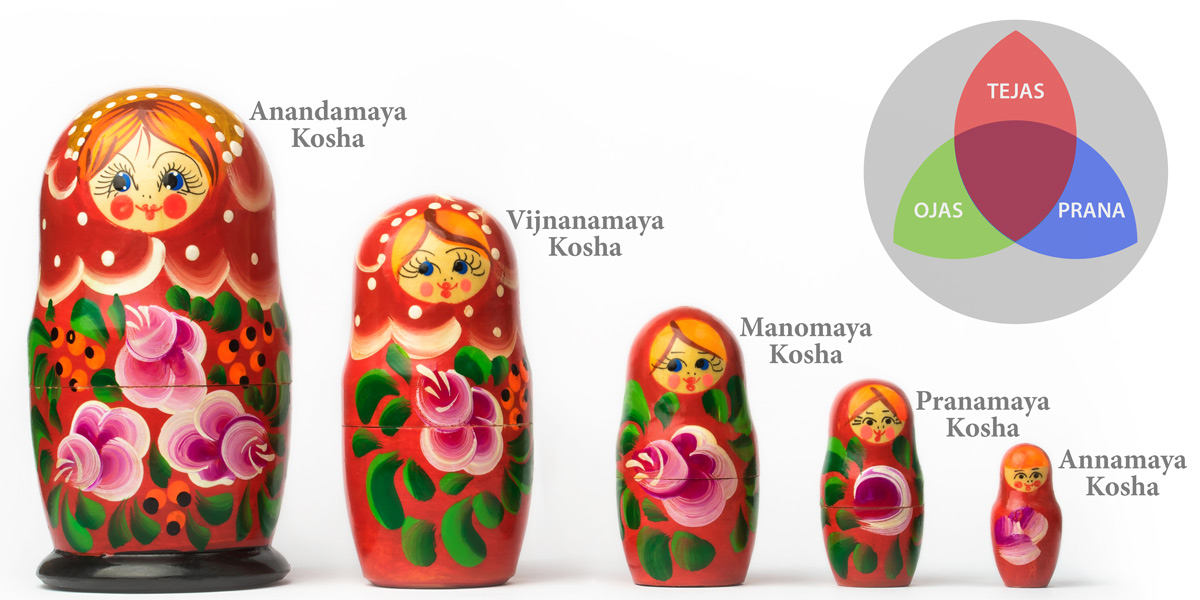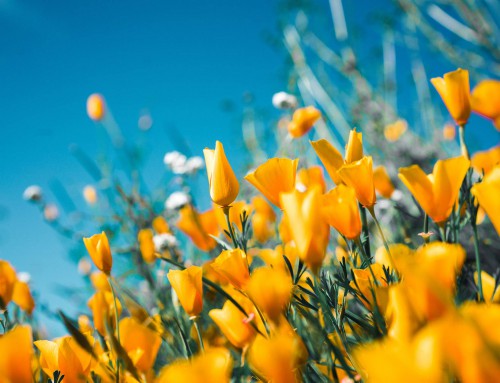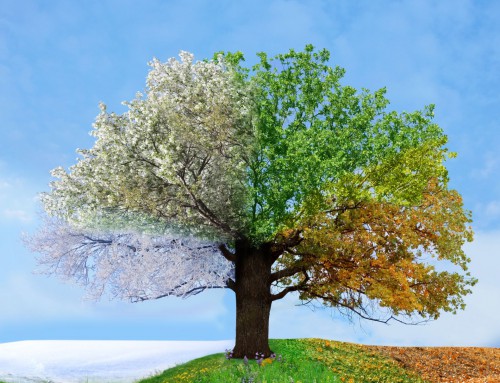
The concept of the three Doshas – Vata, Pitta and Kapha – is most people’s route into understanding Ayurveda. It’s easy to grasp how Vata Dosha can be responsible for all movement, Pitta for all transformations and Kapha for all structure in our body and the world around us.
But there is a deeper level of this understanding though and the three Doshas have their root or master forms, which are sometimes called “the three subtle essences”: Prana (life force and energy), Tejas (radiance and courage), and Ojas (vigour and strength).
 Prana is our life force, energy and vitality and is the root or subtle essence of Vata Dosha. Prana is the guiding intelligence behind all our physiological and psychological functions. It governs processes such as respiration, circulation, digestion and excretion and it coordinates our breath, senses and mind. On a deeper level, it governs the unfoldment and integration of higher states of consciousness.
Prana is our life force, energy and vitality and is the root or subtle essence of Vata Dosha. Prana is the guiding intelligence behind all our physiological and psychological functions. It governs processes such as respiration, circulation, digestion and excretion and it coordinates our breath, senses and mind. On a deeper level, it governs the unfoldment and integration of higher states of consciousness.
Tejas is our inner radiance, lustre, fearlessness, intelligence and understanding. It is the subtle essence of Pitta and the means by which we digest and metabolise the impressions we receive through our senses and the thoughts and emotions that occupy our mind. On a deeper level, Tejas governs the unfoldment of higher perceptual abilities.
Ojas is our primal vigour, strength, immunity, longevity and well-being and is the subtle essence of Kapha as well as of all the seven tissues of our body. Ojas is the storehouse of Bala (strength) and the basis of our physical and mental endurance. It is said that we are each born with eight drops of Ojas in our heart. But Ojas is also seen as the end-product of digestion and present in all our tissues. Ojas is thought of as the glue that holds everything together, including our body, mind and consciousness. It also nourishes and grounds the development of higher states of consciousness.
According to Ayurveda, we don’t just have one body – we have five (see below). While the Doshas have their main influence within our gross physical body, Prana, Tejas, and Ojas work mostly on the level of our subtler bodies.
 Everybody has five bodies
Everybody has five bodies
In the field of Ayurveda, and the related science of Yoga, each of us has five bodies or Koshas. Each Kosha acts as a sheath, which covers or hides our essential nature – our Atman or inner Self.
All five Koshas are interconnected and constantly interacting with each other. There is a sequence within our Koshas, from gross to subtle and, within that sequence, the more refined or subtle Kosha has a regulatory influence on the previous grosser Kosha. Below is a list of the Koshas, from gross to subtle.
Annamaya Kosha
Anna means food and the Annamaya Kosha is the body we build from the food we eat. It is the grossest and most material of all our bodies and the one that we detect through our normal senses. It is usually referred to as our physical body and is associated with the earth element (Prithvi).
Pranamaya Kosha
Prana is often translated as life force. This sheath is our Prana or energy body and it controls the flow of energy through our physical body through a system of subtle channels called Nadis. Our body also has numerous energy centres called Marmas through which our energy body interacts with our physical body. These Marma points control the flow of energy to different body systems and organs, such as our heart, brain, stomach and liver. This Kosha is associated with the water element (Jal).
Manomaya Kosha
Manas means mind and this Kosha acts as a storehouse for memories, emotions, likes and dislikes and all the information we receive through our senses. Manomaya Kosha is often referred to as either our emotional or our mental (Chitta) body and is associated with the fire element (Agni or Tejas).
 Vijnanamaya Kosha
Vijnanamaya Kosha
Vijnana is usually translated as intellect, but can also be thought of as the higher aspect of our mind – our Buddhi. This body is composed of our faculty of intelligence, discrimination, wisdom and compassion. When this sheath is more prominent in our experience, our mind and heart are free of agitation and are balanced and clear. This Kosha is sometimes referred to as our knowledge body and is associated with the air element (Vayu).
Anandamaya Kosha
Ananda means bliss and this sheath is composed of Sattva, bliss, harmony, peace and contentment. Some call this the causal body, others the bliss body. Of all our bodies, Anandamaya Kosha is the truest reflection of our underlying Atman, the Self whose nature is Sat-chit-ananda (pure bliss-consciousness). This Kosha is the most pervasive and is associated with the space or ether element (Akasha).
Ayurveda treats all 5 of our bodies
The reason why Ayurveda is said to be the most holistic medical science is that it not only recognises the existence of our five different bodies or Koshas but it has the deepest knowledge of how to bring each into its optimal state.
Even the production of medicines in Ayurveda is done in such a way as to treat all our bodies. On the gross level there are components within many herbs used in Ayurveda, such as certain alkaloids, that are known for their therapeutic effects on the physical body. But Ayurveda also uses numerous precise and detailed procedures to charge or energise such ingredients, so that they can penetrate and heal our more subtle bodies.
 One example is the process of creating Amlaberry (MA1). Amla fruit is first dried and crushed into a powder. The powder is dipped in fresh Amla juice and this mixture is again dried, ground and mixed with fresh Amla juice. This procedure is repeated 21 times to enhance the nourishing and rejuvenating qualities of Amla. On the physical level the resulting Almaberry helps build muscle tissue and is a Rasayana (rejuvenator). On a subtle level, it strengthens the mental body and intelligence body, it increases inner and outer strength (Bala) and it harmonises the intellect and mind with the physical body.
One example is the process of creating Amlaberry (MA1). Amla fruit is first dried and crushed into a powder. The powder is dipped in fresh Amla juice and this mixture is again dried, ground and mixed with fresh Amla juice. This procedure is repeated 21 times to enhance the nourishing and rejuvenating qualities of Amla. On the physical level the resulting Almaberry helps build muscle tissue and is a Rasayana (rejuvenator). On a subtle level, it strengthens the mental body and intelligence body, it increases inner and outer strength (Bala) and it harmonises the intellect and mind with the physical body.
In order to add specific vibrational qualities to herbs, Ayurveda may recommend picking them at particular times, according to lunar or solar cycles. It may specify certain mantras to be chanted during the preparation of a herbal remedy. Sometimes a herb may be left out in the moonlight or the sunlight to gain a required quality. These are just small examples to show that over many thousands of years, a highly systematised and detailed science has grown up in India to treat the whole person, and that means treating all of our five bodies.
Our physical body is the realm where the three Doshas have their strongest influence and the four subtle bodies are where Prana, Tejas and Ojas have their major effects.
Treat your subtle bodies through the subtle essences
 Healing our four subtle bodies – Pranamaya (energy body), Manomaya (mental body), Vijnanamaya (intelligence body), Anandamaya (bliss body) – primarily involves the balanced promotion of Prana, Tejas, and Ojas.
Healing our four subtle bodies – Pranamaya (energy body), Manomaya (mental body), Vijnanamaya (intelligence body), Anandamaya (bliss body) – primarily involves the balanced promotion of Prana, Tejas, and Ojas.
Meditation, Yoga and Pranayama breathing exercises are powerful tools to balance all three subtle essences and so is maintaining a good digestive system. Here are a few other tips:
Balancing Prana
When the flow of Prana or life force in our body is low, we become weak and lack physical vitality and energy and mental enthusiasm and curiosity; our mind and senses can feel dull and heavy; our immune system becomes lowered and we become prone to disease.
Excessive flow of Prana can result in loss of mental control and motor coordination; learning and behavioural problems such as ADHD; feeling restless, ungrounded and stressed; feeling alienated or losing one’s sense of identity.
When Prana is balanced we feel creative, inspired, enthusiastic and positive; we have a strong desire for life, for growth and for healing; we adapt to new situations easily and desire to connect to others as well as to our own inner Self. When Prana is experienced in its purest, most refined and balanced form, we experience pure bliss and radiate joy.
To balance Prana:
- Get sufficient sleep – go to bed before 10pm and get up by 6am
- Exercise every day and get lots of fresh air in your lungs when exercising
- Do Pranayama and Yoga exercises, which have been specifically designed to increase Prana within our physical body and to balance and energise our Prana body
- Take outdoor walks in the countryside, in woods, on mountains and by the sea to help fill you with Prana
- Drink pure water, which is full of Prana
- Avoid working in stuffy, airless rooms
- Eat freshly cooked meals made with whole ingredients and avoid old foods
- Eat energising foods, such as fresh, organic fruits and vegetables; whole grains like quinoa, barley and amaranth; dairy products such as organic raw milk, lassi and panir (Indian cheese); almonds, cashews and walnuts (soak them first or cook them with grains to make them more digestible). Split yellow mung dhal and other small or split beans are excellent sources of protein
- Kalari Marma Uzhichil is a massage specifically designed to increase the flow of Prana and increase energy and vitality
- Indian Long Pepper (Pippali), ground in a spice grinder and mixed with a little ghee and honey is a Rasayana or rejuvenator for Prana.
Balancing Tejas
When Tejas is too high, this can result in hypersensitivity, auto-immune disorders, excessive weight loss, tension, irritability, stress and nervous disorders. When it is too low your metabolism becomes sluggish, your digestion slows down and your blood can become thick and heavy.
When Tejas is in the right balance you radiate confidence and good health, you have a rosy glow on your skin, there is lustre in your eyes, your mind is clear, you feel fulfilled yet motivated, and you shine with intelligence, energy and vitality.
To keep Tejas in its best condition:
- Only eat when you are truly hungry ands stop eating before you are full
- Take time to sit and rest after eating and don’t exercise immediately after a meal
- Ensure your breakfast and supper are light and easy to digest
- Have your main meal in the middle of the day and sip hot or warm water with your food
- Don’t drink for up to 30 minutes before eating and at least an hour after eating
- To aid digestion, go for a short walk after a meal
- Depending on your Doshic balance and time of year, add Vata Churna, Pitta Churna or Kapha Churna spice mixes to your food to aid digestion
- If your digestion is low, try Trikatu with Cloves before meals to improve your digestive fire
- Take Trikatu mixed with a little honey as a Rasayana for Tejas
- Eat freshly grated ginger, with a little lemon juice, honey and salt before meals, to helps with low appetite
- Use Triphala with Rose to reduce excess Ama – the toxic product of partially digested food
- Bitter ghee preparations, such as Triphala Ghee, help to increase Tejas without increasing Pitta.
Balancing Ojas
Ojas is the product of a good healthy digestion and it promotes mental and physical strength, endurance, stability, calmness, patience, sustained concentration, good memory, contentment and bliss.
Yet, if you consume too many Ojas-promoting foods, such as sweet foods and dairy products, you can overwhelm your digestive fire. This creates the opposite of Ojas, which is Ama, the toxic by product of poor digestion. Those who are overweight and have damp, clammy skin may have consumed too many Ojas-promoting foods. Lethargy, heaviness and lack of motivation can also result.
Low Ojas can result in fearfulness, weakness, being underweight, hyperactivity, erratic behaviour, lack of satisfaction, over-dry skin, premature ageing, low immunity and weakness.
Ojas is depleted by:
- Stressful lifestyle and staying up late
- Excessive TV and computer use
- Overwork and over exertion
- Lack of sleep
- Unhealthy relationships
- Excessive sexual activity (especially by men through loss of semen)
- Grief, anxiety and fear
- Loss of blood
- Drugs and stimulants
- Poor digestion
- Over fasting
- Eating old food
Ojas is increased by:
- Yoga and meditation
- Sufficient good quality sleep
- Love, joy and nourishing life experiences
- Healthy relationships
- Happiness and laughter
- Wholesome lifestyle
- Good digestive fire
- Herbs such as Shilajit, Ashwagandha and Shatavari
- Chyavanprash and other Rasayanas, such as MAK Nectar Paste (MA4) and MAK Ambrosia Tablets (MA5)
- ¼ tsp Triphala mixed with 1 tsp honey and 1 tsp ghee – a Rasayana for Ojas
- Dairy products, especially ghee and whole raw milk
- Fresh, sweet, ripe fruits
- Almond, olive, coconut and sesame oil
- Almonds, cashew nuts, pumpkin seeds, sesame seeds and tahini
- Avocados and sweet potatoes
- Dates, raisins and figs
- Honey, coconut sugar, maple syrup and raw sugar
- Coconut, coconut water and coconut milk
- Whole grains.
A good morning breakfast recipe for deleted Ojas is almond milk. This is how to make it:
- Soak 10 almonds overnight in water
- In the morning, remove the skins and put in a blender
- Add boiled milk, dates, a pinch of cardamom powder, a pinch of ginger powder and one teaspoon of ghee
- Saffron or rose essence may also be added, if available
- Blend this into a delicious Ojas-building drink.
Rasayana for Prana, Tejas, and Ojas
¼ tsp Triphala mixed with 1 tsp honey (approx*) and 1 tsp ghee (approx*) is a Rasayana for Prana, Tejas, and Ojas.
*As Maharishi AyurVeda practitioner, Dr Geoffrey Mead points out, according to Charak Samhita, honey and ghee should never be take in the same quantity as this combination has a negative effect on the physiology (even though, paradoxically, both are considered Rasayanas or nectars). Yet in ancient texts, ghee and honey are sometimes listed as ingredients in a formula without their precise quantities being specified – what to do? Vaidya Gokta was asked this question on my Maharishi AyurVeda training course in 1985 and he said you should go by the time of year. When the season is warmer, ghee should be a little more than honey, as ghee pacifies Pitta and honey aggravates Pitta. In cooler seasons, the opposite should be the case.





